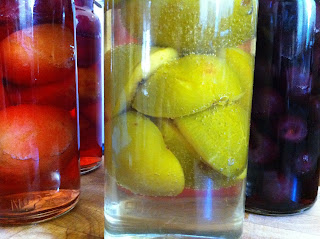Thursday, December 13, 2012
Preserving Seasonal Produce
One of the things I love most about summer is its seasonal produce. Fresh, sunny-day fruits, cool cucumbers and an overload of shiny red (and yellow, and black, and striped!) tomatoes... peach juice dribbling down your chin, onto your hands and leaving sticky, sweet-smelling trails down your arms.... berries included in all manner of meals and snacks, and discovering exactly what mix of berries you need to make light pink, dark pink and purple... scoring a criss-cross pattern into fat, juicy mango cheeks and sneakily scoffing them down before the children see and you have to share.....
Every summer, we spend a few weekend days preserving some of this fresh produce, to use later in the year when it is out of season. We freeze mangoes and bananas, blanch and freeze beans and peas, dry and braid our garlic crops, make liqueurs out of stone fruits, turn apricots, plums, figs and berries into jam, make sauces, paste and passata out of trays of tomatoes, and dry trays of fruits and tomatoes in the oven. We preserve in salt, oil, vinegar and sugar syrup.
One of my favourite ways of preserving is using my aunty's old Fowlers Vacola electric preserver. I was given this unit and boxes and boxes of Vacola jars, lids and clips, all wrapped in newspaper from the 1970s, and I haven't looked back. The internet is a great resource in starting out with bottling (or canning, as they call it in the US).
Last weekend, we were given a tray of kumato tomatoes, a lovely, shiny, little brown variety. We peeled them by scoring them then immersing them first in a pan of boiling water, then in a bowl of cold water. The peels then slide off easily. We then pack the sterilised Vacola jars full, add a bit of citric acid (about a quarter teaspoon to 500g of tomato) and fill with water. The seals, lids and clips are put on, and the jars are processed in the electric unit for 60 minutes.
A note on sterilising jars:
My method of sterilising is to wash the jars and lids thoroughly in hot soapy water, and dry well. I then place them into a cold oven and heat the oven to 160 degrees celsius, and leave jars in there for 10 minutes after temperature has been reached. Make sure the jars are not touching each other in the oven, and be sure to keep them hot until your preserved product is spooned in, as hot foods being put into cold jars will cause the jars to crack.
If using screw top lids, I boil these in a saucepan of water until needed, and use tongs to lift them out and place onto jar. Seal immediately, because as the food cools, it will cause the lids to 'pop' inwards, creating a full seal.
To remove labels from jars easily, I soak all jars in a tub of hot water with some eucalyptus oil, then use a soft scourer to scrape labels off. Make sure jars are then thoroughly cleaned, dried and sterilised as eucalyptus oil is toxic.
Six more jars of whole, peeled tomatoes for the pantry. No preservatives, no BPA.
We also laid out a rack of tomato halves and dried them slowly in a very low oven. When they were dry, we dipped them in apple cider vinegar and placed them in a jar, topping the jar up with olive oil and herbs. Home-dried tomatoes are so full of flavour, and it is so satisfying to eat foods that we have prepared ourselves, for a fraction of the price of the supermarket version.
Do you preserve seasonal foods?
Any favourite preserving recipes/tips/tricks?
Subscribe to:
Post Comments (Atom)







No comments:
Post a Comment
Feel free to pop in here and let me know you are reading along!